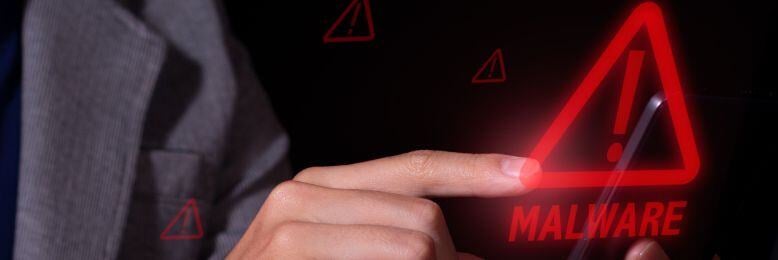December is here—a time to reflect, plan, and protect what matters most. From tackling holiday cyber threats to upgrading your tech for the new year, we’ve got practical tips to help you stay secure, productive, and ready for whatever 2025 brings.
We understand that not everyone loves technology as much as we do. As a Managed Security Services Provider, we are committed to providing practical and useful tips to help make your business more efficient and profitable through the intelligent use of technical solutions!


Editor's note: This post was originally published on November 15, 2020, and has been revised for clarity and comprehensiveness.
Are you worried about falling victim to ransomware attacks? Do you know the critical steps to protect yourself and your business?
With ransomware becoming an increasingly sophisticated threat, businesses are more vulnerable than ever. Rob Schenk, the Chief Security Officer at Intelligent Technical Solutions (ITS), stresses that while cybercriminals constantly adapt, businesses can still mitigate the risk through proactive cybersecurity practices. In this guide, we break down the seven concrete ways to protect your organization and its data from ransomware.
From strengthening password security to setting up reliable backup strategies, here are the essential steps you need to take to stay safe.

A robust password is your first line of defense against cyber threats. Combine complex passwords with multi-factor authentication (MFA) to significantly reduce the chances of unauthorized access. MFA requires users to provide two or more verification factors, making it harder for attackers to breach accounts, even if they obtain a password.
To implement this, set up MFA on all critical accounts and encourage your team to use a password manager to generate and store unique, complex passwords.
Backups are essential in any ransomware attack recovery plan. By maintaining regular backups of critical data, your business can restore operations quickly without paying a ransom. Ensuring backups are stored off-site or in a secure cloud service disconnected from your primary network will also help to avoid ransomware infection.
How often should you back up your data? Schedule daily backups for vital files and verify their integrity regularly to ensure you can recover if needed.
Outdated software is a common entry point for ransomware attackers. Regularly updating operating systems, antivirus programs, and other business software reduces vulnerabilities. Each update often includes security patches that protect against the latest threats, so keeping your systems current is critical.
Whenever possible, enable automatic updates or assign a team member to check for and apply updates weekly. This proactive approach prevents attackers from exploiting known vulnerabilities.
Your team members are on the front lines of cybersecurity. Educating employees on recognizing phishing emails and suspicious links empowers them to avoid ransomware traps. Phishing attempts often contain attachments or links that, once clicked, can install ransomware on a system.
To strengthen your defense, schedule quarterly employee training sessions and conduct simulated phishing tests to evaluate their awareness. Continuous training helps reinforce best practices and keeps everyone alert to potential threats.

Not all employees need access to sensitive data or critical systems. By implementing role-based access control (RBAC), you can restrict permissions based on job responsibilities, minimizing the risk of ransomware spreading across your network.
Managed Detection and Response (MDR) services provide round-the-clock monitoring and advanced threat detection, helping identify ransomware attempts before they escalate. MDR combines human expertise and advanced technology to detect, investigate, and respond to threats in real time, offering a proactive approach to ransomware prevention. This service is especially valuable for businesses without an in-house security team, as MDR providers act as an extension of your IT team.
Consider partnering with an MDR provider to enhance your cybersecurity posture with real-time threat detection and response.
Cloud-based applications are integral to modern businesses but can also become points of vulnerability. By investing in cloud app security solutions that offer real-time monitoring and alerting, you can gain better visibility into suspicious activities and act promptly to mitigate potential threats.
These solutions continuously monitor your applications, flagging unauthorized access or unusual behaviors that may indicate an impending ransomware attack. Ensure your solution includes robust encryption, user behavior analytics, and customizable alerts to stay a step ahead of cybercriminals.

Ransomware attacks continue to be a serious threat to businesses of all sizes, but by following these seven essential practices, you can significantly reduce your risk. From implementing strong passwords and regular backups to training employees and limiting access, each step builds a stronger defense against potential attacks.
Remember, proactive security measures are always more effective than reactive ones. Regularly updating your defenses and educating your team will keep your business prepared against the evolving tactics of cybercriminals. By taking these steps now, you protect your data, ensure business continuity, and avoid the costly consequences of a ransomware attack.
If you want a cybersecurity strategy customized specifically to your business, talk to one of our ITS cybersecurity consultants. You may also check out our free Learning Center resources on ransomware:
%20-%202024-11-01T152130.webp?width=1280&height=427&name=Hero%20Image%20Template%202%20(1280%20x%20427%20px)%20-%202024-11-01T152130.webp)
Securing your personal and professional data is critical for any business, regardless of size. Unfortunately, there are invisible threats that could be waiting to strike. One of them is fileless malware.
Unlike traditional malware, fileless malware doesn’t need to be installed on a target’s system. Instead, it operates in your computer’s memory, exploiting legitimate programs to carry out its malicious activities. That makes it significantly harder to detect and remove.
The question now is how can you protect your business from a threat that can evade traditional detection methods? We can help with that.
Intelligent Technical Solutions (ITS) is an IT service company that with years of experience providing businesses with advanced cybersecurity services. In this article, we’ll arm you with the knowledge to protect your business from fileless malware threats.
Fileless malware is a sophisticated cybersecurity threat that bypasses conventional detection methods used by many antivirus programs. Unlike traditional malware, which relies on files stored on a device’s hard drive, it operates directly within your computer’s memory. It exploits existing legitimate system tools and applications, making them harder to detect.
If you want to protect yourself from this threat, you need to understand the different types, how they’re deployed, and the risks they pose.
Fileless malware can be categorized based on its behavior and attack techniques:
This type exploits applications already installed on the computer or runs directly in the system’s RAM. It hijacks those legitimate processes to inject malicious code into your system’s memory.
To give you a better idea of how that looks, imagine opening a web browser and unwittingly executing the malicious code. It leaves no trace on the hard drive and disappears once the device is rebooted. That may sound innocuous, but don’t be fooled. It can cause significant damage or data loss during its active period. It can capture keystrokes, steal passwords, or redirect users to malicious sites, all without creating or altering files on the hard drive.
Instead of files, this type uses the Windows Registry to execute malicious code. It will embed itself in the registry and persist even after rebooting the system. The malware will then write a script into the registry that is executed every time the computer starts. Once it does, it can download more malicious payloads or enable unauthorized remote access.
This malware performs its malicious activities by running scripts that appear harmless. It uses common scripting languages that are part of standard operating systems, like PowerShell or JavaScript. It’s usually delivered through a phishing email. Once a user clicks the malicious link, the script will run and reach out to an external server. It will then download and execute further malicious commands directly in the system’s memory.

The risks associated with fileless malware are considerable due to how difficult it is to detect and remove.
Traditional antivirus software scans files and directories for known threats. However, fileless malware leaves no files to scan, allowing it to operate undetected.
Fileless malware leverages trusted system tools and processes. Because of that, it typically encounters fewer barriers to execution. That makes it more likely to succeed in its objectives.
Some fileless malware can embed malicious code in the system registry or scheduling tasks. That allows them to persist and remain active even after the system restarts.
Fileless malware can perform a variety of harmful actions. They can steal sensitive information or install even more malicious payloads into your system. That can compromise personal, financial, or business data.

Here are the best ways to protect yourself from fileless malware:
Ensure that your systems and applications are up to date with the latest patches and updates. These updates can fix vulnerabilities that could be exploited by malware. That closes security gaps, making it harder for fileless malware to find a foothold.
Phishing emails are one of the most common entry points for fileless malware. That’s why it’s vital to strengthen your email security. Use tools that scan and filter emails for suspicious links and attachments. In addition, educate yourself and your colleagues about the dangers of unsolicited emails. Teach them the importance of not clicking on unknown links or downloading attachments from untrusted sources.
Fileless malware does not leave typical malware footprints. That’s why it’s better to use security solutions that detect suspicious behavior instead. These tools monitor the system for unusual activities, such as unexpected scripts or unusually high CPU usage. Those might indicate the presence of malware operating in your system’s memory.
Limit the use of administrative privileges on your computer. Fileless malware often needs administrative access to exploit system tools effectively. If you restrict these privileges, you can reduce the malware’s ability to execute its activities even if it does manage to penetrate your system.
Strengthen the security of your endpoints - the devices that connect to your network like computers and smartphones. Employ application whitelisting, which allows only pre-approved programs to run. That can prevent unauthorized use of system utilities by fileless malware. Additionally, consider disabling scripts and macros in applications where they are not necessary.
Some MSPs offer managed cybersecurity services that can secure your entire IT environment. They can help you implement every item on this list to prevent and mitigate fileless malware attacks. Not to mention, they can also offer security information and event management (SIEM) solutions, which help in early detection and prevention.

The stealthy nature of fileless malware makes it a difficult challenge in the realm of cybersecurity. However, by implementing the practical steps covered in this article, you can mitigate the risk of a fileless malware infection.
Remember that you don’t need to take on the challenge of fileless malware alone. If you need help, our team at ITS is ready to provide support. Our ITS Secure package offers advanced cybersecurity solutions, including SIEM solutions that can help you prevent all kinds of attacks, even the ones that can evade traditional detection methods. Schedule a meeting with our experts to get started, or read through our Learning Center resources:
%20(2)-4.jpg?width=1280&height=427&name=Hero%20Image%20Template%202%20(1280%20x%20427%20px)%20(2)-4.jpg)
Is your team’s productivity falling behind? Are you hearing more complaints about computer crashes and network outages in the office? Those might be signs that your technology is being left behind.
As your business grows, the technology that once served you well might start to hold you back. If you’ve noticed increasing frustration from your team or frequent technical issues, it may be time for an upgrade. Ignoring the warning signs can lead to inefficiencies, increased costs, and even security risks.
Intelligent Technical Solutions (ITS) is a managed IT services provider (MSP) with 20+ years of experience helping countless businesses upgrade their technology stack to stay competitive. In this article, we’ll explore six clear signs that indicate your business is due for a technology upgrade.

Here are the telltale signs that indicate your organization is in dire need of a tech upgrade:
Has your team been complaining about how difficult it is to use your existing technology? Do they have to wait on slow systems, or are they experiencing delays due to outdated software? If so, those are clear signs that your current technology is holding you back.
Upgrading your technology can streamline workflows, reduce bottlenecks, and ultimately boost productivity. It ensures that your employees can work more efficiently, allowing them to make better use of their time so they can help drive your business forward.
How often do you experience any of the following: system crashes, network outages, or service interruptions? If the answer is frequent, it’s a major red flag. Downtime can cost your business time and money. Even short periods can cause significant loss in productivity and revenue, not to mention frustration among your team.
If IT issues are a regular occurrence in your current environment, it might be time to invest in more reliable hardware, better software, or even a managed IT services provider. Those can help keep your systems running smoothly. Proactive upgrades can help avoid unplanned downtime and ensure business continuity.
Outdated technology is often more expensive to keep running. Regular maintenance, repairs, and finding replacement parts or compatible software for older systems can be both time-consuming and resource-draining.
Try comparing the cost of maintaining your old tech versus investing in new, more efficient systems. Most of the time, you’ll find that newer technology is typically more energy-efficient, less prone to breakdowns, and often comes with support services that can save you both money and resources.
It’s a fairly simple concept: if your tech is outdated, so is your security. Older systems lack modern security features, making them easier targets for cybercriminals. If you don’t want to fall victim to a preventable cyber attack, you might want to consider upgrading your systems.
Having up-to-date technology is crucial to protecting your sensitive business data. If your current systems don’t support advanced security protocols like encryption, multi-factor authentication (MFA), or regular security patches, it’s time for an upgrade.
If employees start creating workarounds to handle your existing technology's limitations, you have a great team of driven individuals. Unfortunately, they’re wasting their time and energy creating makeshift solutions instead of helping grow your organization. It strongly indicates that your current technology no longer meets your needs.
Dealing with workarounds and makeshift solutions can help get the work done. But over time, inefficiencies will add up and slow things down. That could lead to increased errors, frustration, and wasted time. Upgrading your technology could provide a more cohesive tech stack that helps streamline your processes. That way, your technology works with your team instead of against them.
Technology advances very quickly. The problem is that your current systems will need to keep up. Older systems will eventually become incompatible with the latest hardware and software. So, if you’re having trouble adopting new tools or integrating modern systems, it’s a clear sign that you’re falling behind.
Continuing to use old, incompatible tech will prevent you from taking advantage of emerging technologies that could provide significant benefits to your organization. Ensuring your systems are compatible with the latest tech ensures you stay competitive, helping future-proof your organization.

Recognizing the signs that your technology needs an upgrade is crucial to stay competitive. It also helps prevent costly downtime, security risks, and inefficiencies that can harm your organization. Investing in the right upgrades doesn’t just mean you’re solving problems; it also means you’re setting your organization up for long-term success.
If you recognize any of the signs we mentioned above, it might be time to take action. At ITS, we specialize in helping businesses modernize their tech to stay ahead of the competition. Contact us today to discuss how we can support your technology upgrade and keep your business running smoothly. You can also check out the following resources for more info:
%20(1)-3.jpg?width=1280&height=427&name=Hero%20Image%20Template%202%20(1280%20x%20427%20px)%20(1)-3.jpg)
From wireless communication to hands-free work environments, Bluetooth devices have made life more convenient. However, they’ve also introduced a host of hidden vulnerabilities that can compromise your business’s security.
Many organizations overlook Bluetooth security, underestimating how easily attackers can exploit these connections to access sensitive data or disrupt operations. The problem is that Bluetooth-enabled devices like smartphones, laptops, and even printers are constantly in use, and each one could serve as an entry point for hackers.
With decades of experience protecting businesses from all kinds of cyber threats, our team at Intelligent Technical Solutions (ITS) believes that Bluetooth security should be on your radar. Otherwise, you might be leaving the door open for cyber threats to infiltrate your network uncontested.
In this article, we’ll explore eight common Bluetooth risks that could be affecting your business right now—and we’ll dive into how you can mitigate them effectively.

When considering Bluetooth security for your business, it's important to be aware of several vulnerabilities and risks that could impact your network, devices, and data. Here are the most common Bluetooth risks to watch out for and how to address them:
Bluejacking involves sending unsolicited messages to nearby Bluetooth-enabled devices. Attackers use this technique to push messages or advertisements onto a victim's device without their consent.
While bluejacking is typically harmless and more of an annoyance, it can be used to send spam or phishing messages that trick users into downloading malicious content or providing sensitive information.
Bluejacking typically occurs because Bluetooth devices are often left in discoverable mode, which allows anyone in range to detect and send messages to them. While not inherently dangerous, bluejacking could serve as a gateway to more severe attacks, such as phishing. Attackers could trick users into clicking on malicious links or giving away credentials.
How to Mitigate It:
Ensure Bluetooth devices are set to “non-discoverable” mode when not actively pairing with other devices and educate employees about not interacting with unsolicited Bluetooth messages.
Bluesnarfing is a more dangerous attack where an unauthorized person gains access to information on a Bluetooth-enabled device without the owner’s consent. The attacker can steal sensitive data like contact lists, messages, emails, calendars, and even files. This can lead to significant data breaches, especially if the device contains confidential business information, such as customer data or proprietary business materials.
Unlike bluejacking, which is more of an annoyance, bluesnarfing allows for serious data theft. Attackers can silently connect to a victim's device and siphon off private information. With business devices, this could mean the loss of sensitive corporate data like financial records, client lists, or proprietary technology.
How to Mitigate It:
Ensure devices have strong pairing authentication, such as PINs or passkeys, and use Bluetooth encryption to protect transmitted data. Encourage employees to turn off Bluetooth when not needed and avoid pairing in public spaces.
Bluebugging is a sophisticated Bluetooth attack that allows attackers to take control of a victim’s device. Once connected, the attacker can make phone calls, send messages, and even access data stored on the device. Attackers can take full control of the device, potentially compromising sensitive communications, stealing data, and making unauthorized calls or texts. Bluebugging can even allow attackers to eavesdrop on conversations.
Bluebugging is more dangerous than bluesnarfing because attackers can gain remote control over the target device. This means they can listen in on calls, manipulate apps, access sensitive data, or even use the device’s internet connection for malicious purposes. In a business setting, this could lead to significant privacy violations, corporate espionage, or financial fraud.
How to Mitigate It:
Regularly update device firmware to patch vulnerabilities and disable Bluetooth when not in use. Use strong pairing codes and monitor device activity for signs of unauthorized access.
In an MITM attack, an attacker intercepts the communication between two Bluetooth devices and either listens in or alters the information being exchanged.
MITM attacks can result in data breaches where sensitive information like authentication credentials, personal data, or business communications are intercepted. The attacker could also modify messages in transit, leading to misunderstandings or manipulation of data.
Bluetooth MITM attacks occur when two devices communicate over an unsecured connection, allowing an attacker to hijack the communication. This can happen if the devices are using weak or outdated encryption protocols, allowing the attacker to decrypt and read messages. For businesses, this could mean stolen credentials, intercepted communications, or even manipulated business data.
How to Mitigate It:
Ensure that Bluetooth communication is encrypted using the latest standards. When pairing devices, use secure methods like numeric comparison or passkey entry to verify authenticity and avoid public pairing sessions where MITM attacks are more likely.
BlueBorne is a collection of vulnerabilities that allow attackers to take control of devices through Bluetooth, even if the device isn’t actively paired with another. BlueBorne attacks can allow attackers to completely take over devices, steal sensitive information, spread malware, and propagate throughout an entire network if other vulnerable devices are connected.
Unlike traditional Bluetooth attacks, BlueBorne doesn’t require the attacker to be paired with the victim’s device. They only need to be within Bluetooth range. This attack exploits vulnerabilities in the Bluetooth protocol itself and can allow the attacker to gain access to all the device's features, including the camera, microphone, files, and applications. BlueBorne can spread malware throughout a network, posing a huge risk to businesses.
How to Mitigate It:
Update all devices regularly to ensure that the latest security patches are applied. Disable Bluetooth when it’s not in use and limit its use to trusted environments.
In this attack, an attacker impersonates a trusted Bluetooth device to trick users into connecting to it. Users may inadvertently connect to a malicious device, allowing attackers to intercept communications or push malware onto the victim’s device.
Attackers can spoof the MAC address of a legitimate Bluetooth device, causing the target device to believe it's communicating with a trusted entity. This can lead to unauthorized access or even allow attackers to install malicious software on business devices. For businesses, this could mean compromised communications, data loss, or malware infections spreading through the network.
How to Mitigate It:
Ensure that employees are trained to recognize suspicious Bluetooth connection requests and verify device legitimacy before connecting. Devices should be set to require manual approval before pairing.
Older Bluetooth versions have weaker encryption and outdated security measures that attackers can easily exploit. Devices using these outdated protocols are more susceptible to attacks like bluesnarfing, MITM, and bluebugging.
Older Bluetooth standards, such as Bluetooth 1.x or 2.x, lack advanced encryption and security mechanisms that are present in more recent versions like Bluetooth 4.2 and 5. These older protocols are prone to various types of exploits, including data interception and unauthorized access. Businesses relying on devices with outdated Bluetooth protocols are leaving themselves open to attacks.
How to Mitigate It:
Always update devices to support the latest Bluetooth versions and security features. Ensure that older devices with outdated protocols are replaced or properly secured.
One of the most common Bluetooth vulnerabilities comes from employees who leave their devices in discoverable mode or connect to insecure devices without realizing the risks. Employees may unknowingly expose their devices to attackers by connecting to unsecured Bluetooth devices in public spaces, or by neglecting to disable Bluetooth when it’s not in use.
Human error, such as leaving Bluetooth enabled in a public setting or failing to authenticate a trusted device, can lead to attacks like bluejacking, bluesnarfing, or MITM. Employees may inadvertently connect to rogue devices, which can then access sensitive information or inject malicious code. The lack of awareness around Bluetooth security can often result in the most significant breaches.
How to Mitigate It:
Conduct regular employee training on Bluetooth security best practices, such as turning off Bluetooth when not needed, avoiding pairing with unknown devices, and ensuring that device settings are properly configured. Use Mobile Device Management (MDM) solutions to enforce security policies across the organization.

Bluetooth technology can significantly enhance the convenience and efficiency of your business. However, without the right security measures, it can also open the door to serious risks. From device impersonation to data theft, Bluetooth vulnerabilities shouldn't be ignored. If you want to protect your business from these unseen dangers of Bluetooth technology, you need to understand the potential threats and take proactive steps to secure your devices.
At ITS, we’re here to help you strengthen your Bluetooth security and overall cybersecurity strategy. Contact us today for a free IT security assessment. You can also check the following resources for more ways to reduce cyber risk:
January 21, 2025, Tuesday, 11:00 AM PT | 2:00 PM ET
Cybersecurity shouldn’t start after an attack—it begins with identifying and eliminating risks before they can be exploited.
Join Rob Schenk, Chief Security Officer at Intelligent Technical Solutions, and Earl Fischl, Director of Service Strategy at Field Effect, as they break down the critical steps to proactive cybersecurity.
What You’ll Learn:
